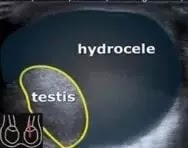The collection of serous fluid in some parts of the 'Tunica vaginalis' is called a hydrocele. It occurs in males. There are seven layers of the scrotum. From outside inwards:-
- Skin
- Dartos fascia and muscle
- External spermatic fascia
- Cremasteric fascia
- Internal spermatic fascia
- Tunica vaginalis
- Tunica albuginea
When the fluid collection in the sixth layer (Tunica vaginalis) then hydrocele forms. Another name is Processus vaginalis.
Classification:
Congenital
Acquired:
- Primary or idiopathic
- Secondary (due to disease of testes and epididymis)
Etiology / Causation
The primary or idiopathic hydrocele is perhaps due to low-grade infection of testis/epididymis or after a mild trauma to the scrotum. In tropical countries, it is mostly to filarial epididymal-orchitis and funiculitis. The lymphatics along the spermatic cord, draining the tunica are obstructed due to recurrent lymphangitis.
Hydrocele can be produced in four sources:
By excessive production of fluid within the sac e.g secondary hydrocele.
By defective absorption of hydrocele fluid by the tunica vaginalis.
By interference with the drainage of fluid by lymphatic vessels of the cord.
By connection with the peritoneal cavity as in congenital variety.
Constituents of Hydrocele fluid:
It is amber-colored. It contains water, inorganic salts, albumin, and a quantity of fibrinogen. In old standing cases, fluid sometimes contains cholesterol and trypsin crystals. Microfilaria may be found in hydroceles of filarial origin especially in chylocele.
Symptoms:
- Enlargement of the scrotal sac.
- It May be unilateral or bilateral
- No pain but uneasiness
- Pain occurred when getting trauma or filarial epididymal-orchitis
- Decrease cosmetic looks
- Penis is buried
Diagnosis:
Ninety-nine out of 100 hydroceles is translucent.
On examination, it is possible to get above the swelling.
Clinical features: The patient reports a scrotal swelling of insidious onset.
These may be H/O trauma or a periodic dull ache in the scrotum with occasional low grads fever for filarial epididymal-orchitis. Ram horn penis.
The swelling is pyriform in shape. It may be unilateral or bilateral. The swelling is confined to the scrotum and cystic inconsistency. The penis is buried.
The fluctuation test is positive.
The swelling is translucent unless the tunica or scrotal skin is very thick.
In vaginal hydrocele testis can not be palpable. The epididymis may be palpable at the back of the swelling like a boat-shaped solid structure.
Treatment:
Surgical
A. Eversion of sac
B. Excision of an extra portion of sac in large hydrocele (hydrocelectomy / Jabonlay's Operation)
C. Lord's operation- This is done when tunica is not thickened. The incision is given through all layers of the Scrotum including tunica vaginalis. Testes are prolapse through the wound and interrupted suture is applied in the tunica. (Ruffing of the tunica).
Homeopathic medicine
Abrotanum is good medicine for this condition
If there is h/o of trauma, Arnica M in higher potency.
Besides Pulsatilla and Rhodendron another good medicine.


Post a Comment